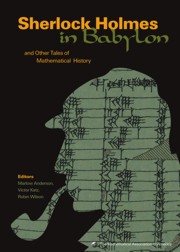Book contents
- Frontmatter
- Introduction
- Contents
- Ancient Mathematics
- Medieval and Renaissance Mathematics
- The Seventeenth Century
- The Eighteenth Century
- Foreword
- Brook Taylor and the Mathematical Theory of Linear Perspective
- Was Newton's Calculus a Dead End? The Continental Influence of Maclaurin's Treatise of Fluxions
- Discussion of Fluxions: from Berkeley to Woodhouse
- The Bernoullis and the Harmonic Series
- Leonhard Euler 1707–1783
- The Number e
- Euler's Vision of a General Partial Differential Calculus for a Generalized Kind of Function
- Euler and the Fundamental Theorem of Algebra
- Euler and Differentials
- Euler and Quadratic Reciprocity
- Afterword
- Index
- About the Editors
Euler and the Fundamental Theorem of Algebra
from The Eighteenth Century
- Frontmatter
- Introduction
- Contents
- Ancient Mathematics
- Medieval and Renaissance Mathematics
- The Seventeenth Century
- The Eighteenth Century
- Foreword
- Brook Taylor and the Mathematical Theory of Linear Perspective
- Was Newton's Calculus a Dead End? The Continental Influence of Maclaurin's Treatise of Fluxions
- Discussion of Fluxions: from Berkeley to Woodhouse
- The Bernoullis and the Harmonic Series
- Leonhard Euler 1707–1783
- The Number e
- Euler's Vision of a General Partial Differential Calculus for a Generalized Kind of Function
- Euler and the Fundamental Theorem of Algebra
- Euler and Differentials
- Euler and Quadratic Reciprocity
- Afterword
- Index
- About the Editors
Summary
A watershed event for all students of mathematics is the first course in basic high school algebra. In my case, this provided an initial look at graphs, inequalities, the quadratic formula, and many other critical ideas. Somewhere near the term's end, as I remember, our teacher mentioned what sounded like the most important result of them all—the fundamental theorem of algebra. Anything with a name like that, I figured, must be (for want of a better term) fundamental. Unfortunately, the teacher informed us that this theorem was much too advanced to state, let alone to investigate, at our current level of mathematical development.
Fine. I was willing to wait. However, second-year algebra came and went, yet the fundamental theorem occupied only an obscure footnote from which I learned that it had something to do with factoring polynomials and solving polynomial equations. My semester in college algebra/precalculus the following year went a bit further, and I emerged vaguely aware that the fundamental theorem of algebra said that nth-degree polynomials could be factored into n (possibly complex) linear factors, and thus nth-degree polynomial equations must have n (possibly complex and possibly repeated) solutions. Of course, to that point we had done little with complex numbers and less with complex solutions of polynomial equations, so the whole business remained obscure and mysterious. Even in those pre-Watergate days, I began to sense that the mathematical establishment was engaged in some kind of cover-up to keep us ignorant of the true state of algebraic affairs.
- Type
- Chapter
- Information
- Sherlock Holmes in BabylonAnd Other Tales of Mathematical History, pp. 361 - 368Publisher: Mathematical Association of AmericaPrint publication year: 2003



